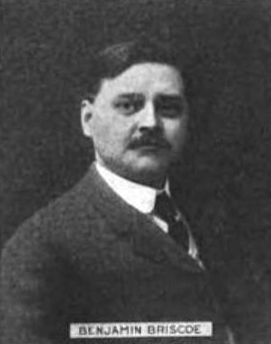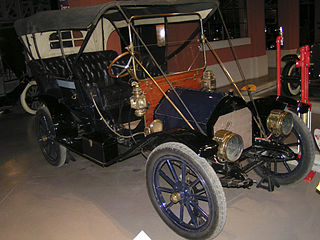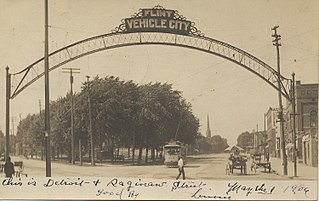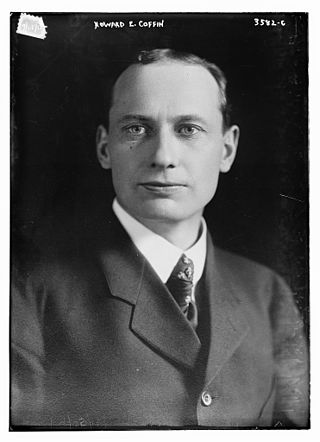
General Motors (GM) is an American multinational automotive manufacturing company headquartered in Detroit, Michigan, United States. The company is most known for owning and manufacturing four automobile brands, Chevrolet, GMC, Cadillac and Buick. By sales, it was the largest automaker in the United States in 2022, and was the largest in the world for 77 years before losing the top spot to Toyota in 2008.

Buick is a division of the American automobile manufacturer General Motors (GM). Started by automotive pioneer David Dunbar Buick in 1899, it was among the first American automobile brands and was the company that established General Motors in 1908. Before the establishment of General Motors, GM founder William C. Durant had served as Buick's general manager and major investor. With the demise of Oldsmobile in 2004, Buick became the oldest surviving American carmaker.

McLaughlin Motor Car Company Limited was a Canadian manufacturer of automobiles headquartered in Oshawa, Ontario. Founded by Robert McLaughlin, it once was the largest carriage manufacturing factory in the British Empire.

William Crapo Durant was a leading pioneer of the United States automobile industry, founder of General Motors and co-founder of Chevrolet. He created a system in which a company held multiple marques – each seemingly independent, with different automobile lines – bound under a unified corporate holding company. Durant founded General Motors and co-founded Chevrolet with Louis Chevrolet. He also founded Frigidaire.

Durant Motors Inc. was established in 1921 by former General Motors CEO William "Billy" Durant following his termination by the GM board of directors and the New York bankers who financed GM.

Star was an American automobile company that was assembled by the Durant Motors Company between 1922 and 1928. Also known as the Star Car, Star was envisioned as a competitor against the Ford Model T and Chevrolet. In the United Kingdom, it was sold as the Rugby, to avoid confusion with the British marque.

The Dort Motor Car Company of Flint, Michigan, built automobiles from 1915 to 1924.

Mason Motors, founded by A. C. Mason in cooperation with William C. Durant, was a U.S. truck manufacturer based in Flint, Michigan. As a subsidiary of Durant Motors, Mason Truck built Road King Speed Trucks in the early 1920s. Mason Motors also built automobile engines in 1911, who first led Buick's engine works in Flint. That company was absorbed by Chevrolet in 1915, but remained under the Chevrolet umbrella until January 1, 1918, when it became known as the Motor and Axle Division of Chevrolet.
The De Vaux was an automobile produced by the De Vaux-Hall Motors Company of Grand Rapids, Michigan, and Oakland, California. It was founded by Norman de Vaux and Elbert J. Hall. The company was incorporated on December 15, 1930. The company sold automobiles under the "DeVaux" brand from April 1931 until February 1932, when the company went into receivership.

Benjamin Briscoe was born in Detroit, Michigan, and was an automobile pioneer and industrialist.

The Everitt was an American automobile manufactured from 1909 until 1912 by the Metzger Motor Car Company in Detroit, Michigan.

Russell Clifford Durant was an American playboy and racing driver.

Flint, Michigan is a city which previously relied on its automotive industry, and still does to an extent. Over the past several decades, General Motors plants in Genesee County have experienced re-namings, management shifts, openings, closures, reopenings, and spinoffs.
Little Motor Car Company was an automobile manufacturing company founded primarily by William H. Little and William C. Durant that operated from 1911 to 1913. Built in Flint, Michigan, the company was eventually incorporated into the current Chevrolet Motor Company.

Durant-Dort Carriage Company was a manufacturer of horse-drawn vehicles in Flint, Michigan. Founded in 1886, by 1900 it was the largest carriage manufacturer in the country.

Howard Earle Coffin was an American automobile engineer and industrialist. He was one of the founders of the Hudson Motor Car Company with Roy D. Chapin. He was a charter member of The Society of Automotive Engineers and president in 1910, and as one of the "dollar-a-year men" served as chairman of the Aircraft Board which organized aircraft production and industrial mobilization during World War I. He retired from the Hudson company in 1930 but acted as a consultant. He died accidentally in 1937.

Josiah Dallas Dort was an American engineer and automobile pioneer of the United States automobile industry. He was born in Inkster, Michigan on February 27, 1861. His father was a well-to-do country squire and merchant, well connected politically, who died in 1871 when Josiah was 10. Dort left school at age 15 to help his mother in business and to work at a crockery firm. He moved to Flint, Michigan in 1879. In 1881, he began working at a Flint hardware store, and within a few years opened his own hardware store.
The W.F. Stewart Company was an American carriage body and automotive body manufacturer founded in 1881 by William Francis Stewart and based in Flint, Michigan. The company specialized in the design and manufacture of wooden carriage bodies for horse-drawn transport and later automotive bodies. The company also briefly produced light aircraft, but went out of business in the Great Depression.
Flint Wagon Works of Flint, Michigan, manufactured wagons from the early 1880s. One of the world's most successful horse-drawn vehicle makers they formed with their Flint neighbours a core of the American automobile industry. In 1905 Flint was promoting itself as Flint the Vehicle City. The former site is now located in the neighborhood of Flint known as "Carriagetown".

Durant-Dort Factory One is a former cotton textile, carriage, and automobile factory in Flint, Michigan, that is now an archive and a center for research, meetings, and the community. The building was constructed in 1880 as a cotton textile factory. It produced carriages for the Durant-Dort Carriage Company from 1886 to 1917 and then produced cars for the Dort Motor Car Company from 1917 to 1924. It is often considered the birthplace of General Motors (GM).


















